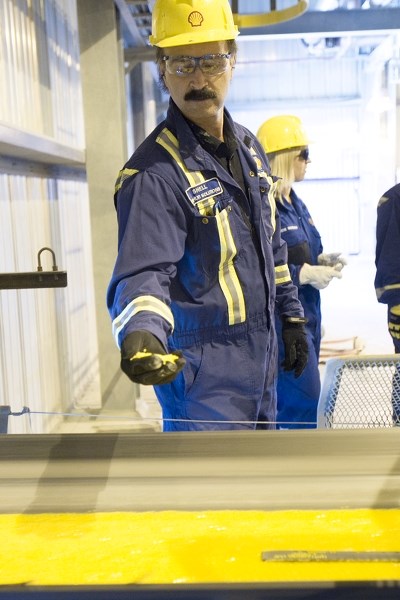More than two decades after first starting operations, the Shell Shantz plant continues to turn thousands of tonnes of molten sulphur into solid grain-sized pellets for shipment overseas every week.
Located just north of Highway 582 and west of Highway 22, the facility processes liquid sulphur from the Shell Caroline Gas Complex plant, with the sulphur shipped to Shantz through a 42-kilometre-long underground pipeline.
Sulphur is also brought to the plant by trucks from other gas plants and facilities in West Central Alberta.
To date, the Shantz facility has produced more than 34 million tonnes of pellets, called pastilles, which are used mostly in the production of fertilizer and other products such as tires and medicines, and in mining operations.
The pastille-making process involves feeding molten sulphur into one of 46 pelletizing units called rotoformers, each costing $750,000 in 1992.
In the rotoformers tiny droplets of sulphur are sprayed onto stainless steel conveyers, where the droplets are cooled into solid form.
The pellets are then transported along a conveyer belt into two massive storage silos. From there the pastilles are loaded onto trains for transportation to West Coast ports.
Taking six hours to load, the 2.4-kilometre-long trains come through the plant about every six days. Each train carries about 11,200 tonnes of pellets.
There are 25 workers at the Shantz facility, which operates 24 hours a day.
Although the plant continues to do exactly the same job it was designed for when it first opened in October 1992, over the years a number of modifications and upgrades have been made to keep up with technology and environmental guidelines, said plant superintendent Dave Kolesnik.
“There has been add-ons,” Kolesnik said during a tour of the facility on May 13. “We haven't added too much more equipment per se, but we modified the equipment that we do have. For example, we've modified the rotoformers so they can produce more from each machine.
“A lot of the stuff that has been added on is to be more environmentally friendly and friendly with the surrounding residents.”
Examples of other changes include the addition of new computer and video monitoring systems, and wind fences on the storage silos, he said.
“That (the fences) helps keep the dust from going off site,” he said. “We've done a lot more paving. The standards are also becoming more rigid. We want to constantly keep up to date.
“We have to stay on board with that and stay ahead of that. Being up to date environmentally is a big, big thing.”
Changes to the way surface water is collected and processed have also been made over the years to meet new standards for treatment.
“Any water (from rain or snow) in the ditches is all funnelled in and it's treated to government standards by a third-party company,” he said. “And there was a lot (of runoff) after the recent winter. Our ponds were getting really, really full.”
Production at the facility has actually come down in recent years, he said.
“That is mainly because our biggest supply of feed stock is from the Caroline Gas plant and its field is slowly going down. We are actively looking at bringing in feed stock from other sources,” he said.
“Employee numbers have been pretty steady over the years. It has been unchanged over the past 15 years,” he added.
The planned shutdown of the Shell Burnt Timber gas plant northwest of Cremona shouldn't have much impact on the Shantz plant, he said.
“It will affect us in that it will cut down on some of our production, but it wasn't a huge part of our production,” he said. “It will affect us a little bit.”
The shortage of train transportation capacity in recent months – a shortage that has hurt grain farmers in the region – has had some impact on the Shantz facility too, he said.
“Do we see a difference? Definitely yes,” he said. “We haven't been to a point where a train hasn't come and we have to pour (sulphur onto blocks at the site). We've come close at times, but it hasn't happened. You can see a difference on them getting the trains here on time.”
Asked if the Shantz plant has a lifespan, a time when it will close, he said, “I can't tell you exactly. Hopefully it will be here for a long time.”
The pipeline from Shell Caroline to the Shantz plant will also remain in operation for the foreseeable future, he said.



